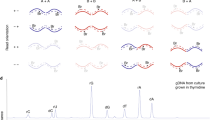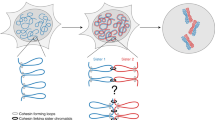Abstract
THE 33258 Hoechst fluorescence1 and 33258 Hoechst–Giemsa2 methods for differential staining of bromodeoxy-uridine (BrdU)-incorporated chromatids are attractive because of their rapidity and high sensitivity in revealing small sister chromatid exchanges which escape detection by autoradiography. Since carcinogen-induced chromatid breaks are associated with sister chromatid exchanges3 and breakage formation parallels carcinogenesis in typical cases4,5, these methods are essential for understanding the role of chromosome aberrations in carcinogenesis. We show here that other photosensitive dyes such as thionin can replace 33258 Hoechst in the latter method and that the mechanisms of the differential Giemsa method involves photolysis of the BrdU-substituted DNA combined with these photosensitive dyes.
This is a preview of subscription content, access via your institution
Access options
Subscribe to this journal
Receive 51 print issues and online access
$199.00 per year
only $3.90 per issue
Buy this article
- Purchase on Springer Link
- Instant access to full article PDF
Prices may be subject to local taxes which are calculated during checkout
Similar content being viewed by others
References
Latt, S. A., Proc. natn. Acad. Sci. U.S.A., 70, 3395–3339 (1973).
Perry, P., and Wolff, S., Nature, 251, 156–158 (1974).
Sugiyama, T., J. natn. Cancer Inst., 47, 1267–1275 (1971).
Sugiyama, T., Gann, 64, 637–639 (1973).
Nichols, W. W., Hereditas, 50, 53–76 (1963).
Ikushima, T., and Wolff, S., Expl Cell Res., 87, 15–19 (1974).
Seabright, M., Lancet, ii, 971–972 (1971).
Shibatani, A., and Naora, H., Experentia, 8, 268–270 (1952).
Regan, J. D., Setlow, R. B., and Ley, R. D., Proc. natn. Acad. Sci. U.S.A., 68, 708–712 (1971).
Kato, H., Nature, 251, 70–72 (1974).
Bowen, E. J., and Wokes, F., Fluorescence of Solutions (Longman, London, 1953).
Author information
Authors and Affiliations
Rights and permissions
About this article
Cite this article
SUGIYAMA, T., GOTO, K. & KANO, Y. Mechanism of differential Giemsa method for sister chromatids. Nature 259, 59–60 (1976). https://doi.org/10.1038/259059a0
Received:
Accepted:
Issue Date:
DOI: https://doi.org/10.1038/259059a0
This article is cited by
-
DNA denaturation for ultrastructural banding and the mechanism underlying the fluorochrome-photolysis-Giemsa technique studied with anti-5-bromodeoxyuridine antibodies
Chromosoma (1989)
-
Different effects of 33258 Hoechst and DAPI in fluorescent staining of sister chromatids differentially substituted with bromodeoxyuridine
Histochemistry (1982)
-
Visualization of centromeric spots in the chromosomes by UV-light exposure
Experientia (1982)
-
The role of chromosomal proteins in the induction of a differential staining of sister chromatids by light
The Histochemical Journal (1981)
-
Involvement of sulfhydryl groups of chromosomal proteins in sister chromatid differentiation
Chromosoma (1980)
Comments
By submitting a comment you agree to abide by our Terms and Community Guidelines. If you find something abusive or that does not comply with our terms or guidelines please flag it as inappropriate.



